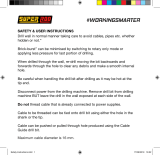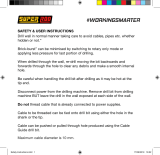POWX153 EN
Copyright © 2021 VARO P a g e | 13 www.varo.com
13 SERVICE DEPARTMENT
Damaged switches must be replaced by our after-sales service department.
If the connecting cable (or mains plug) is damaged, it must be replaced by a particular
connecting cable which is available from our service department. Replacement of the
connecting cable must only be carried out by our service department (see last page) or by a
qualified person (qualified electrician).
14 STORAGE
Thoroughly clean the whole machine and its accessories.
Store it out of the reach of children, in a stable and secure position, in a cool and dry place,
avoid too high and too low temperatures.
15 WARRANTY
▪ This product is warranted for a 36-month period effective from the date of purchase by the
first user.
▪ This warranty covers all material or production flaws excluding: batteries, chargers,
defective parts subject to normal wear & tear such as bearings, brushes, cables, and
plugs, or accessories such as drills, drill bits, saw blades, etc. ; damage or defects
resulting from maltreatment, accidents or alterations; nor the cost of transportation
▪ Damage and/or defects resulting from inappropriate use also do not fall under the
warranty provisions.
▪ We also disclaim all liability for any bodily injury resulting from inappropriate use of the
tool.
▪ Repairs may only be carried out by an authorised customer service centre for Powerplus
tools.
▪ You can always obtain more information at the number 00 32 3 292 92 90.
▪ Any transportation costs shall always be borne by the customer, unless agreed otherwise
in writing.
▪ At the same time, no claim can be made on the warranty if the damage of the device is the
result of negligent maintenance or overload.
▪ Definitely excluded from the warranty is damage resulting from fluid permeation, excessive
dust penetration, intentional damage (on purpose or by gross carelessness), inappropriate
usage (use for purposes for which the device is not suitable), incompetent usage (e.g. not
following the instructions given in the manual), inexpert assembly, lightning strike,
erroneous net voltage. This list is not exhaustive.
▪ Acceptance of claims under warranty can never lead to the prolongation of the warranty
period nor commencement of a new warranty period in case of a device replacement.
▪ Devices or parts which are replaced under the warranty therefore remain the property of
Varo NV.
▪ We reserve the right to reject a claim whenever the purchase cannot be verified or when it
is clear that the product has not been properly maintained. (Clean ventilation slots, carbon
brushes serviced regularly, etc.).
▪ Your purchase receipt must be kept as proof of date of purchase.
▪ Your appliance must be returned undismantled to your dealer in an acceptably clean state,
(in its original blow-moulded case if applicable to the unit), accompanied by proof of
purchase.
16 ENVIRONMENT
Should your appliance need replacement after extended use, do not discard it with
the household rubbish but dispose of it in an environmentally safe way.
Waste produced by electrical machine items should not be handled like normal
household rubbish. Please recycle where recycle facilities exist. Check with your
Local Authority or retailer for recycling advice.















